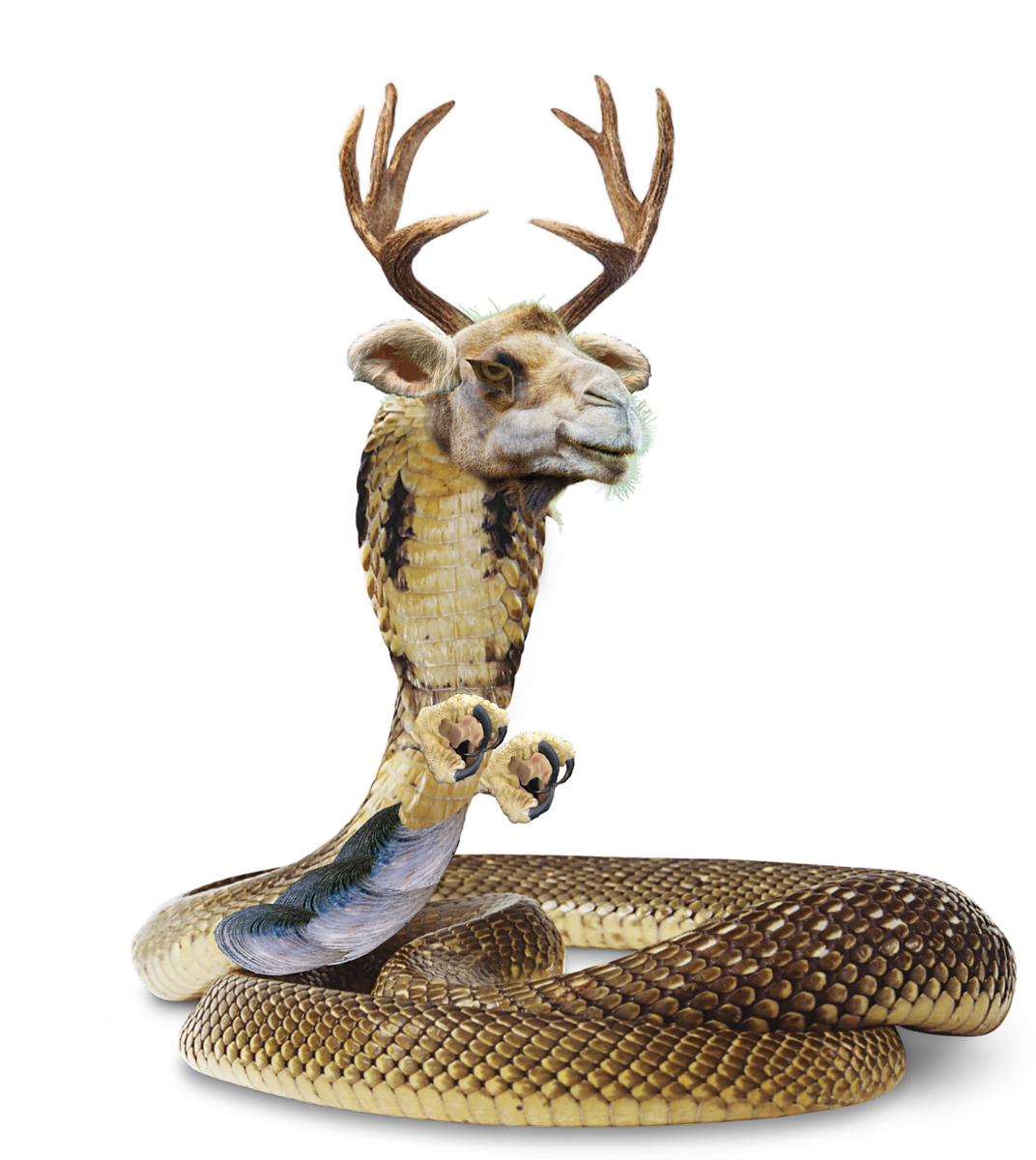Alice Sparkly Kat’s Meditations on the Year of the Dragon
In Fang Lizhi’s essay, “The Chinese Amnesia,” published in the New York Review of Books in 1990, the Chinese Astrophysicist begins by unpacking the dragon as a metaphor for China: “To symbolize the Chinese people by a dragon, a creature that does not exist, may seem to imply that the Chinese people are unique in kind,” he writes. “This runs counter to my fundamental belief that human nature is universal and admits no distinctions of race.”
This Lunar New Year, as we enter the year of the Green Dragon, it is worth reflecting on what, exactly, a dragon is. Dragons are weird chimeras. As described by the Han dynasty scholar Wang Fu, dragons have a camel’s head, deer antlers, snake bodies, carp scales, clam bellies, cat eyes, eagle hands, and tiger paw pads. If we were to photoshop all of these elements together, we would end up with something like the creature illustrated here.
In a way, Asia, as it’s understood by the west, is also a chimera. As a continent, it includes every nation and identity from Palestine to Japan. Meanwhile, places like Russia, Australia, and Turkey are sometimes seen as Asian and sometimes not. There’s something ridiculous about it. How could one label be used to describe people from as wide of a geography as the Middle East to the Philippines? Being AAPI is especially chimera-like.
Like the dragon, as AAPI, we inhabit an imaginary space between Asia and the west. We also often exist in two different realities. In western mythology, dragons are seen as malevolent beings with wings who often hoard treasure in mountains. In Asia, dragons are wingless, and float through the sky using a magical chimu. These dragons are lucky.
But a dragon is much more than a mythic chimera. Dragons are not just imaginary but geographical. A dragon is also a watershed. The mountains where freshwater forms are the dragon’s bones and the creeks and rivers where water flows are dragon veins. A dragon is long, it flows, and it controls the weather. In ancient historic records about floods, we hear about dragons that are eight feet tall. According to the Guanzi, dragons can be as small as a silkworm or as big as the universe. The size of a dragon is always changing.
All living things descend from dragons because all life forms out of water. In this way, Fang Lizhi is right—there is nothing unique about being a descendant of a dragon. River deltas, where the river meets the sea, are the most fertile places in the world. Dragons are chimeras not because identity is a chimera but because water is where life mutates. As long as life can mutate, it can continue.
Even rivers mutate. Rivers come from mountain glaciers—frozen water is a sleeping dragon. As these sleeping dragons wake and flow in the spring, the season of the dragon, they also turn into clouds and rain. This atmospheric river is a floating dragon.
The last time we had a Green Dragon year was the year 1964. In that year, Nelson Mandela delivered his historic speech, “I Am Prepared To Die”, from a dock in Johannesburg, South Africa. Addressed toward the Palace of Justice,—where he along with ten other members of the African National Congress were being tried for sabotage, communism, and aiding foreign powers during the infamous Rivonia Trials—Mandela stood on the banks of a river and underscored that the battle against South Africa’s policy of apartheid was not merely symbolic but material.
“Our fight is real and not imaginary,” he declared, speaking in depth about apartheid’s effects on soil erosion, malnutrition, and poverty. “I have done whatever I did, both as an individual and as a leader of my people, because of my experience in South Africa and my own proudly felt African background.”
In 2024, as we enter another Green Dragon year, I want us to remember Mandela’s words from 1964. I want us to remember that we are all children of dragons and stewards of bodies of water—from Standing Rock to Flint, Michigan to the Mediterranean Sea, all struggles for water are connected.
I want us to remember the true chimeric nature of the dragon as a metaphor for the fluid nature of identity. Identity is more than a symbol. Identity is an origin point and the symbols that form our identities can always change. Symbols are not worth protection. Rivers, as sources of life, are. Borders and nation-states are built from imagined symbols but geological fault lines and the land are real.
—Alice Sparkly Kat is an astrologer. Their goal is to bring reconstruction and historicism back into astrology and to bring mysticism back into storytelling. Their astrological work has inhabited MoMA, Philadelphia Museum of Art, and The Brooklyn Museum. They’re the author of “Postcolonial Astrology” (May 2021). Their website is alicesparklykat.com.

